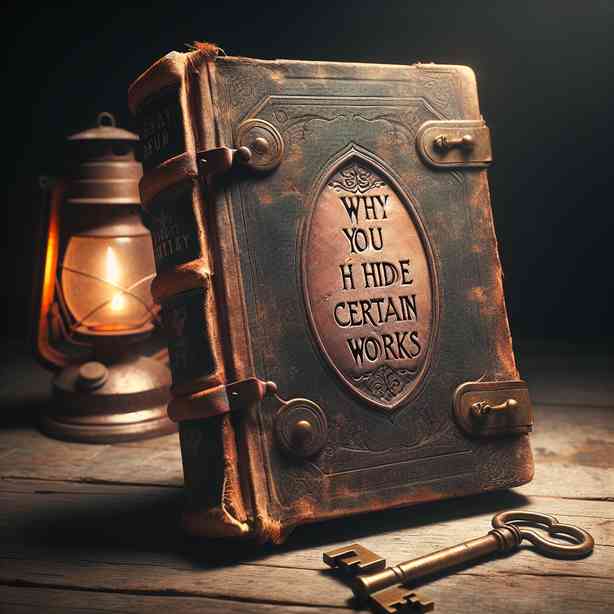
In the realm of art and creativity, there exists a profound and often perplexing phenomenon: the decision to hide certain works. This practice is not only observed among artists and creators but can also extend to various fields such as literature, music, cinema, and even academic research. As we delve into the intricacies of why certain works are concealed, we will explore various dimensions such as personal expression, societal impact, creative integrity, and the psychological underpinnings of this decision.
One significant reason for hiding works is the deeply personal nature of artistic expression. Artists often pour their emotions, experiences, and vulnerabilities into their creations. While some pieces may reflect their rawest selves, others might reveal thoughts and feelings that the artist finds too private or painful to share with the world. This decision to hide can serve as a protective mechanism. By concealing certain works, artists maintain a boundary around their intimate thoughts, ensuring that only those who truly understand or empathize with their experiences can access those fragments of their lives.
Moreover, societal norms and cultural expectations play a pivotal role in an artist’s decision to withhold their work. The fear of judgment or misinterpretation can be daunting. Artists often navigate complex landscapes of public perception and criticism, where sensitivity to social issues or political climates can influence their willingness to share. For instance, a work that challenges societal norms or addresses controversial topics may be suppressed due to fears of backlash or alienation. This phenomenon is particularly evident in environments where censorship is prevalent. The desire to conform to societal expectations can prevent artists from showcasing works that might provoke discomfort or provoke necessary discussions.
Beyond personal and societal considerations, creative integrity is also a significant factor in the decision to hide certain pieces. Artists may choose not to release some works simply because they feel those pieces do not meet their own standards of quality or originality. This self-imposed judgment can lead to the belief that the hidden work does not represent their true artistic voice or vision. In this context, hiding becomes an act of preservation, ensuring that an artist’s portfolio reflects the best of their capabilities. This phenomenon can be closely tied to the imposter syndrome many creators experience, where an individual doubts their accomplishments and fears being exposed as a “fraud.” By concealing works perceived as subpar, they protect their creative identity and maintain their credibility within the artistic community.
Furthermore, psychological factors also play a crucial role in the tendency to hide certain works. The creative process often comes with highs and lows, and artists may struggle with self-doubt. A piece that feels personal may also carry the burden of vulnerability. The rejection or criticism of that work could hit harder than a more detached creation. Thus, hiding certain pieces can be a way to manage anxiety about reception and diminish the risk of personal hurt. Artists may also grapple with the fear of their work being misinterpreted or reduced to mere labels. By choosing to keep some works hidden, they can retain ownership over their narrative and control over how their art is perceived.
As we consider the implications of hiding art, it is essential to acknowledge the dynamic relationship between the creator and their audience. The act of concealing a work can sometimes increase its allure. Much like the concept of “forbidden fruit,” a hidden piece may spark curiosity and interest among fans and critics alike. This psychological phenomenon can create an enigmatic quality around the artist, inviting speculation and discussion about their hidden works. As a result, certain creations may attain a legendary status, enhancing the mystique surrounding the artist and their oeuvre.
In the digital age, where access to artistic works is unprecedented, the act of hiding certain pieces takes on new dimensions. Online platforms allow for immediate sharing, yet they also amplify the potential for criticism and harsh feedback. When the boundary between the creator and the audience is blurred, the stakes of sharing personal work can feel considerably higher. Many artists respond to this pressure by curating their public personas meticulously, showcasing only what they deem worthy of public consumption. This selective sharing can leave a considerable body of work – rich with insights and experiences – hidden from view.
Additionally, the cultural context can influence the perception of hidden works. In some cases, hidden pieces may reflect the socio-political environment of the artist’s time. When creative expression is constrained by cultural repression or authoritarian regimes, artists may find themselves compelled to hide their work for safety or to protect their message. In these contexts, the act of hiding becomes both a survival strategy and a means of subversion, allowing artists to retain their voice and authenticity amidst oppressive circumstances.
In conclusion, the decision to hide certain works stems from a complex interplay of personal, societal, and psychological factors. Artists navigate their creative landscapes with sensitivity, weighing their desire for authenticity against the potential risks of exposure. Whether driven by fear of judgment, concerns over artistic quality, or the need for personal preservation, the act of hiding can be seen not merely as a refusal to share but as a nuanced response to the challenges inherent in artistic expression. Understanding why artists choose to conceal certain works deepens our appreciation for their complexities and the intricate nature of the creative journey. The hidden pieces that remain unsung often hold profound significance, echoing the fears, hopes, and truths that define humanity itself.


